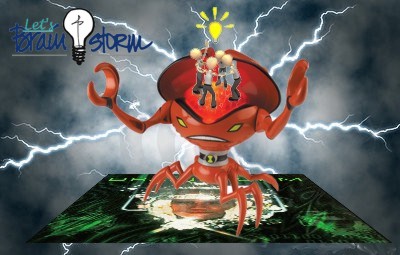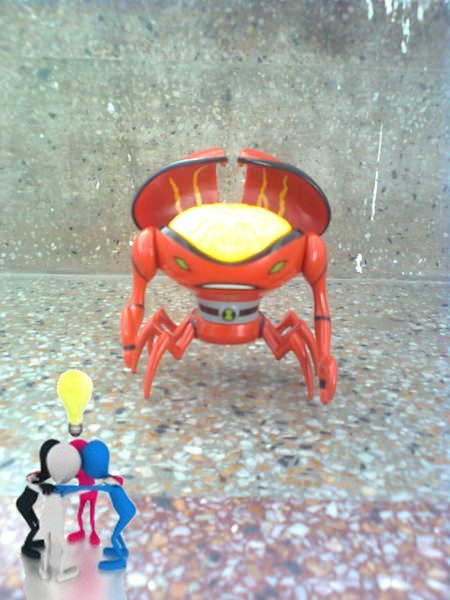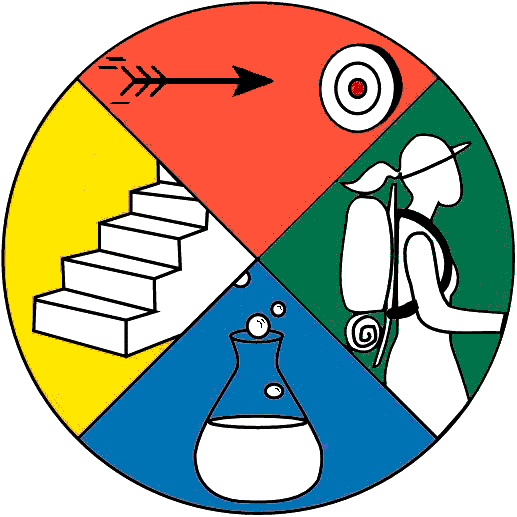

|
Introduction
|

• Anticonventional Thinking (ACT) is a creative thinking methodology that, unlike many others, actively encourages, rather than discouraging,
criticism. Because criticism Feeds Creativity.


By the concurrent and ongoing procedures of defining problems, pitching ideas, combining, refining and building there upon, the exchange of fault finding criticism to expose and correct weaknesses in the work, and document sharing to flesh out the prose. In creative writing and business planning alike, writing is rewriting and
never a waste of time!Creative collaboration can be an intensive and informal process, meeting underserved stimulus needs of nurture for intelligence via optimal optimal reciprocal engagement including steady emotional support, exploration and fun, active participation, sensory stimulation, with opportunity for social interaction, freedom from undue pressure and dystress though suffused with a degree of pleasurable intensity or: eustress, with varied selection and alternatives of successive novel challenges neither too easy and boring nor too difficult and frustrating, promoting lifelong growth in a broad range of skills and interests, intellectual, physical, aesthetic, social and emotional. Engagement, visceral or intellectual, elicits the intrinsic motivation of perseverance and concentration.
Even the very Art of Active Reading is far from passive, intellectual and interpretive participation entailing construction of alternative narratives, imagination and visualization, adjustment of emphasis to suit one's own interests, and assembly of the story or information into whatever the cognitive schemata and context that make up one's own systems of knowledge and belief.
In the words of Toni Morison: “The ability of writers to imagine what is not the self, to familiarize the strange and mystify the familiar, is the test of their power.” For as Eve Tushnet expounds in ‘Eros and Education,’ even so integral and elemental a vital impulse as sex is meaningful expression of Eros, more than the quest for completion and transformation, the oft frustrated desire for connection, liberating union with alien difference inevitably first demanding resolution out of conflict on many levels arising from any dread of the vulnerability entailed.
Some collaborative tasks, basically review and comprehension, only require primarily recall and repetition of material or simple application of pertinent concepts. Such tasks depend only upon mastery of skills and content such as may entail working together to review and digest known information, conduct proof reading or clarification and correction of one other's comprehension in conceptualization. By contrast, there are other collaborative tasks that entail a higher, more complex level of cognitive processing, including collaboration to restructure and solve ill-structured problems, identification and free choice among several possible solutions, analysis and integration of ideas going beyond accumulated material into the actual construction of new knowledge, collaborative decision making, assessment and review. Such more complex tasks challenge high-level cognitive processing; that is, Critical Thinking, problem solving, creativity and decision making. High-level cognitive processing that involves making inferences, drawing conclusions, synthesizing ideas, generating hypotheses, comparing and contrasting, finding and articulating problems, analyzing and evaluating alternatives. Therefore, thinking and interaction among the participants must be of a high cognitive level, characterized by the exchange of ideas, information, perspectives, attitudes, and opinions, discussion as to generate thought-provoking questions, explanations, speculations, justifications, inferences, hypotheses, and conclusions, with reciprocal intervention including explicit guidance whenever interaction falls short.
Serendipity refers to fortunate discoveries that come about by accident. Of course, accidental discoveries cannot be automated, but opportune conditions can be contrived or manufactured in which such events are more likely to occur. And brainstorming exploits this phenomenon of manufactured or cultivated serendipity.
One salient point in support of brainstorming fiction in specific, is that even though a finished plot must generally be linear, in the activity of fiction writing the process of plotting probably should not be. Rather, it may be is best to arrange and rearrange the story components one has, in order to then understand the implications and fill in the blanks, an ideal challenge for brainstorming.
In any application or context, brainstorming can be initiated at any point of a planning process to generate ideas or just to "break the ice" and get people interacting.
And, posting Online, there is no problem butting in, or need to take turns. And private reflection becomes public expression at the click of the send button. Nor need there be delays or time limits.
In all things, the dynamic and flexible social engineering principles, personal autonomy, good sportsmanship and responsible values of rational democratic progress are systematic doubt, hope in the honest embrace of fallibility and tolerance for uncertainty, substantive discourse, debate of disputes, criticism without punishment and no insult taken, free inquiry into problems openly and publicly without fear of punishment, indeed, imagination, open unfounded speculation about different case scenarios pursuant to any number of varied and different proposed measures, without need of conforming or in any way limiting said speculations to any accepted quasi-official position.
The very values and aptitudes ever fostered in brainstorming and fiction writing!
And all pursuant to experiment, trial and error, the vital opportunity for all manner of ongoing reevaluation and revision, open ended correction of mistakes and improvement at all levels, piecemeal, without bloodshed, violence or even strife as such.
The
Dialectic of Socrates embracing Valuable Intellectual Traits and dimensions of Critical Thinking in the practice of controversy which is the free exchange of criticism, all predicated upon a straight forward willingness to speak one's mind openly, question whatever one does not understand, and to respond seriously to questions or objections raised or put to one by others. While brainstorming is predicated upon the eagerness to spin permutations and connections back and forth. And every problem solved raises new problems to solve, fresh creative opportunities.Therefore, manipulative sulking protest, antithetical both to criticality and creativity, simply will not do at all. When the ball is in one's court, it comes time to return the serve. Not to fling feces! No flaming, whining or sulking!
Is there truly anything new under the sun? From whence do original ideas spring out from the either? Overcoming writer's block is not unlike like trying to tickle oneself, isn't it? That is one of the problems with the solitary writer model of fiction authorship. The Muse does not come when called. But sometimes she crashes parties!
Similar principles apply, also, to practical problem solving and the drafting of viable plans. And for brainstorming as a applied to planning from scratch, find a broad selection of planning tools and unfinished drafts for document sharing, much of which are available free of cost, at planware.org
Problem solving helps to inspire ideas that in turn bring to mind associated ideas and refinements. The most interesting ideas are those with the most and the best creative points of departure, meaning the most fruitful in giving rise to divergent streams of thought and more new ideas and associations. The least interesting ones are those that fail to inspire, and don't seem to lead anywhere.
And all too often, one of the greatest sore points, but nevertheless most crucial criticism for fanfic remain the fundamentals of fiction writing, that offer cogent explanation of the exciting avenues and the disappointing dead ends of story crafting. Thus, it is no accident that a FAQ on fiction writing fundamentals, an How-To, follows this very FAQ concerned with the importance of the free exchange of Critical Thinking in writing collaboration.
Document sharing is an informal process by which participants question, correct, annotate and rewrite one another's work, back and forth, until output takes shape and becomes more polished, in successive iterations. Indeed, collaborative brainstorming among creative people is a wonderful creative tool for the evocation of inspiration, where in, for example, different people interacting pose story problems or other creative challenges, pitch solutions in response, and then synthesize one another's variant notions. While, of course, correcting one another's mistakes and shoring up drawbacks and weaknesses. Each participant posts their drafts independently for all to review, and then all the drafts are discussed and the best ideas from each are retained for ongoing revision into another round of drafts. This cycle may be repeated until a finished polished work begins to take shape.
Most who ever are so fortunate as to participate in such exercise of creative brilliance and community, on leave from the mundane and routine, find themselves much happier with other worthy individuals engaged in any worthwhile undertaking or project, than to labor in obscure solitude once again, drab and ordinary, a tremendous let down.
Q. What
is the desired outcome of collaborative story brainstorming?A.
Only the stimulus to creativity.One common method of story or script writing, is to establish the premise early on, and then to follow standard dramatic plot structure. At worst, this can easily degenerating into clichéd hack, no matter how appealing the initial premise. And even worse with no such appealing premise!
And, of course, this applies no less to any other linear thinking processes, planning or procedure.
nevertheless, given sufficiently profound insight, even any one idea may give rise to a cascade of consequence. And such is the traditional core both of human Drama and of the impersonal Sociological extrapolation that is Science Fiction or even Futurology and invention.
But another creative approach that may be applied to fiction writing, among other things, is brainstorming, to derive and extrapolate new associations and corollaries from an idea, only as much as thence proceeds. And to do this with more than one idea at a time. And then, to find connections or make new links between them, to relate the various ideas, one to another.
Thence to derive coherent logical sequence from which to develop a story line or solve all manner of problems, meet different types of challenges, more creatively.
And brainstorming may be the more fertile in tandem, by writing or planning partners or in collaborative fiction or proposal writing communities, even then solitarily.
Beyond that, when fiction authors brainstorm together, sometimes they complete works in collaboration, and other times they create entirely separate works off on their own. Or one can do both!
benefit does brainstorming offer to creative writing including fiction?
A.
Writer's block, a common problem, is such dearth of ideas which often is what happens for want of enough of the right input stimuli. And one can either seek further inspiration, or else one must make do.One common method of story or script writing, is to establish the premise early on, and then to follow standard dramatic plot structure. At worst, this can easily degenerating into clichéd hack, no matter how appealing the initial premise. And even worse with no such appealing premise!
Or, given sufficiently profound insight, even any one idea may give rise to a cascade of consequence. And such is the traditional core both of human Drama and of the impersonal Sociological extrapolation that is Science Fiction.
But another creative approach that may be applied to fiction writing, among other things, is brainstorming, to derive and extrapolate new associations and corollaries from an idea, only as much as thence proceeds. And to do this with more than one idea at a time. And then, to find connections or make new links between them, to relate the various ideas, one to another. Thence to derive coherent logical sequence from which to develop a story line.
And brainstorming may be the more fertile in tandem, by writing partners or in collaborative writing communities, even then solitarily.
After all:
"Philosophers, writers, artists, even scientists, not only need encouragement and an audience, they need constant stimulation from other people. It is almost impossible to think without talking."
George Orwell -
Conversation with a PacifistFor, again, as Eve Tushnet expounds in ‘Eros and Education,’ even so integral and elemental a vital impulse as sex is meaningful expression of
Eros, more than the quest for completion and transformation, the oft frustrated desire for connection, liberating union with alien difference inevitably first demanding resolution out of conflict on many levels arising from any dread of the vulnerability entailed.
 |
|
But
"A union in which one partner [or unloved idea] is not vulnerable is an invasion; if neither partner submits, it is an armed truce. [And] Neither of these experiences frees us from the tyranny [and intrinsic loneliness of self involved banality]."And, in the alternative, brainstorming may help not only to conjure up novelty but fearless merger with original and even alien perspectives, even like unto to following Abraham Lincoln's famous self-instruction:
"I do not like that man; therefore I shall get to know him better" but applied to thoughts, notions and ideas no less than to people.
Q. What is the crucial importance of posting conventions?
A. Quality interactivity online generally still depends upon asynchronous text communication, private or public response to previous private or public messages by others, often excerpted or quoted for context.
The revolutionary quick turn around of electronic asynchronous text communication makes unprecedented actual conversation in typed correspondence possible!
In the excitement of
traditional brainstorming, onsite, the group participants shout out ideas in
rapid fire, responding each to one another. But Nominal Brainstorming begins,
instead, by each participant sitting silently compiling a written list on their
own. Whereas Electronic Brainstorming simply refers quite broadly to the
utilization of intermediating software, either for collation of entries over
time or in electronic meetings or even by various and often bizarre,
manipulative and
alienating structuring and/or anonymizing filtration and
devious "facilitation" or
consensus
manipulation.
However, the particular Electronic Brainstorming modality of
FoolQuest.com,
instead stressing openness, is to proceed by means of asynchronous text
communication on electronic message posting forums, unless, of course, by email
for privacy in case of sensitive material or proprietary deliberation.
Asynchronous text communication enables Electronic Brainstorming incorporating,
also, the individual work and private contemplation of Nominal Brainstorming.
The entire problem of quick response or else taking turns or otherwise
apportioning time simply no longer applies. Rather, it must be for each
participant to allocate the precious investment of their attention and effort.
Nor need cross-talk be discouraged or suppressed.
And for any in depth exchange or Dialectic, a very important aspect of quoting never to be underestimated, is how the quotes should indicate what sections or points of a message that any given remark replies to. Often there may be certain response to some sections or points of a message, and distinct other responses to about other sections or points even of the same message. And it will be crucial to see, readily, which response pertains to which point, in order to make much sense of any of it. And the best way to convey all of this clearly and distinctly, is to quote a little bit, interject some comments, quote some more, and then interject some comments specifically to that as well, and so on. Each answer in turn, follows the same method, and an entire written conversation unfolds, point by point, iteration by iteration.
Quotes should be indicated, automatically, by your email software or service, by a character at the beginning of each line, usually a '>' (greater than) sign, the right angle bracket or right brocket, in bare plain text, or by a blue bar in html that supports colors, sizes and fonts, etc.. or on some forums, by a range of different indications such indentation of the text. Thus, with each iteration, another such indicator is added at the beginning of the line, so that chronological order as well as intended sequitur will always be clearly indicated as the conversation proceeds.
These principles of the quoting conventions handed down from Usenet, even back from the days of Arpanet, are still applicable in any mode of asynchronous text communication, electronic forums, message posting boards, list servers, egroups, and email, etc.
Q. So, is brainstorming serious and for real?
After all is said and done, much is said and little is done. — Olmstead
A.
One common objection to the somewhat unrestrained freewheeling of brainstorming is that without more of some sort of structure, where does action ever emerge from planning, and where comes the product of this endless cultural process that is discourse?But, first of all, what is meant here by "action" and why is it important? fiction writing, for example, is a discourse. In such collaboration that proceeds out of brainstorming, the authors need only kick a document back and forth until it steadily becomes more finished. For writing, especially fiction, that well suffices. And needless structure only becomes stifling.
By contrast, however, even proposal writing for such more complicated undertakings as entrepreneurial early stage business start-ups and initiatives of political activism may very badly need operational structure. And ignoring or denying that need dooms even bold inspiration into pipe dream. For even great visions may remain still born for want of crucial logistical considerations.
All in all, grandiose organizational structure is easiest when least needful. Meanwhile the only freedom of imagination that comes to such megalomania is just wishful thinking and denial rather than creativity and problem solving.
Another failure of collective thinking is when the very questions are arbitrary and pointless, and the suggestions unimaginative, putting the proverbial cart far before the metaphorical horse. But even, however rarely, when dealing with decisions that might conceivably make an effective difference somehow, nevertheless even discussion at all to the point still tends to reduce to pointless expression of position and preference that remain genially arbitrary for wont of Critical Thinking about the real situation and whatever principles apply thereto.
In other words, even majority decisions may be rendered meaningless, sans any focus upon whatever real issues, and in terms of whatever such issues (such as any pertinent question of what might be more dramatic and why in fiction, or salient questions of what it takes to influence government or make business viable) so crucial to informing any more meaningful discourse.
All classic problems of any system eclipsing it's own purpose, internal agenda instead of any external motivating goal put forth. Such is all that comes from the consensus of people who are not challenging to one another and stop caring.
In
brainstorming, by contrast, definition of problems, or visioning, is both crucial and a distinct aspect of creativity.All that is is the result of what we have thought. — Suttapitaka
 Click here to proceed
onward to SECTION II:
Click here to proceed
onward to SECTION II: Technique, procedure and pitfalls...